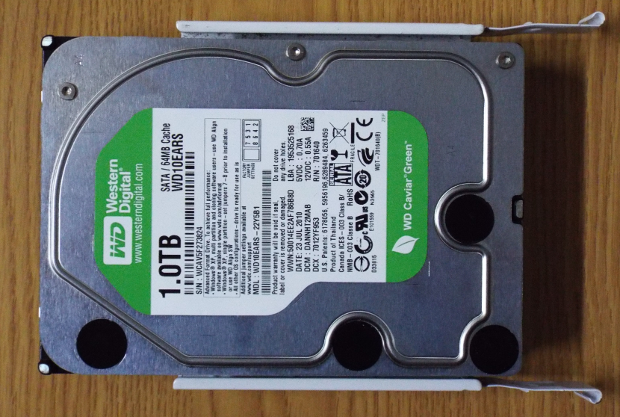WD CAVIAR GREEN 1TB HDD ONLY BENCHMARKS
Those of us who have been utilizing SSDs as boot drives for any length of time at all have likely forgotten how sloooooooooow HDD boot-up times are by comparison. In order to utilize our Western Digital Caviar Green 1TB HDD for this testing, we first had to migrate our operating system from our test bench SSD over to the HDD. We accomplished this using Acronis TrueImage cloning software. After the cloning operation was complete, we disconnected the SSD and rebooted from the HDD, and waited…….., and waited……….., for a total of nearly two minutes for the HDD to fully boot up to a usable desktop. We then installed the Greatis Bootracer software, rebooted, and waited……, and waited…….., and at least this time the Bootracer software is giving us an exact clock measurement of this lengthy boot time.
As with the SSD, Crystal DiskInfo shows us our HDD’s serial number and firmware version, and that S.M.A.R.T. is operational (not being an SSD, TRIM is grayed out). As you can see from the “power on count” and “power on hours”, this is an “experienced” HDD we are utilizing for our testing, and its health status shows as “good”.

Beginning with transfer sizes of 64KB (and larger), the WD Caviar Green 1TB HDD maxes out its read speed capabilities at 110-116 MB/s. The write speeds plateaued at 105-106 MB/s.
CRYSTAL DISK BENCHMARK VER 3.0X64
With compressible data (left screenshot), the WD Caviar Green 1TB HDD’s sequential read and write speeds are nearly identical at 106.0 and 106.8 MB/s. One of the inherent weaknesses of spinning-platter HDDs is low 4K performance, as evidenced by the single-digit 4K read/write speeds ranging from 0.495 to 1.414 MB/s.
Surprisingly enough, the HDD actually does just a tad better in the random (incompressible) tests, as shown in the right-hand screenshot.
Benchmarking the WD Caviar Green 1TB HDD with AS SSD does not have much value on its own, but we have included it in keeping with the “before / after” (un-cached / cached) testing methodology being used.
In looking at AS SSD Copybench results, remember the “good old days” that included such lengthy waits for files, programs or games to load or download?
ANVIL STORAGE UTILITIES PROFESSIONAL
As with AS SSD, the Anvil benchmark of the WD Caviar Green 1TB HDD is included to compare with the HDD’s benchmarks when used in conjunction with the SuperCache 2 mSATA SSD as a combined caching partition.
BOOT TIMES
Utilizing Greatis Software’s Bootracer boot time charting application logged our WD HDD’s total boot times at 76-78 seconds. See the Bootracer screenshot at the end of the HDD BENCHMARKS WITH CACHING TURNED ON section.
 The SSD Review The Worlds Dedicated SSD Education and Review Resource |
The SSD Review The Worlds Dedicated SSD Education and Review Resource | 

To see gains in write performance you must enable Maximized mode by un-checking the Enhanced Mode Button. We have told Fnet to please make it so there are options there instead of just un-checking enhanced mode. It will run at full SSD glory if you un-check that button. The reason there is no advantage in write performance while in enhanced mode is because it is actually writing to the HDD. You will see a huge difference in performance after un-checking that box.
Hope you can update your review. Also SC2 drives can be used as boot drives for more experienced users.
MyDigitalSSD
The copy of the HybriDisk software supplied by MyDigitalSSD had the “enhanced mode” checked by default, and it could not be unchecked by the user. We re-downloaded it from the link on the product page and same result.
MyDigitalSSD is more than welcome to supply an updated version of the software
that allows the user to uncheck the “enhanced mode”
and we will be more than happy to re-benchmark it.
We also need to bear in mind that with caching solutions, the tradeoff of disabling enhanced mode can be a lower level of data protection in the event of a power interruption.
Totally my bad next version will allow unchecking. Coming very very soon.
We already have it putting it up on the site shortly. Thanks for the heads up.
Its ready for DL https://www.mydigitaldiscount.com/fnet and works! Full Speed SSD without any technical skills other than using a screw driver and downloading a program is required for this upgrade.
Also I don’t know what low density SSD you have available in your arsenal but I am pretty sure that the SC2 puts most low density SSD’s to shame both read and write in sustained and 4k. When you go down to the 64GB, 32GB, and 24GB most other SSD’s are in fact slower than an HDD. The Phison S9 controller is the only controller I know of that can deliver real SSD performance at low densities. The 128GB SC2 is the only example in the line slower than a 2.5″ counterpart while the other densities are in reality the only good option on the market for low density SSD..
MyDigitalSSD
And one more thing the whole point of this cache drive is to give people with mSATA ports the option of keeping their large spinner for storage while getting SSD speeds vs. their HDD. Both as a cache drive and boot drive. It is not meant to be the next fastest SSD in the world which for the average user doesn’t mean squat because they will definitely be able to tell the difference in speed vs an HDD but could not tell the difference in regular use between this SSD and the fastest SATA SSD around.
MyDigitalSSD
I am ordering today to try with my new Clevo W230st – will report once it gets here
Could you please post a link to Amazon for that “SATA III TO MSATA ADAPTER” ?
https://www.amazon.com/gp/product/B00GSRCCT6/ref=as_li_ss_tl?ie=UTF8&camp=1789&creative=390957&creativeASIN=B00GSRCCT6&linkCode=as2&tag=mydig0b-20